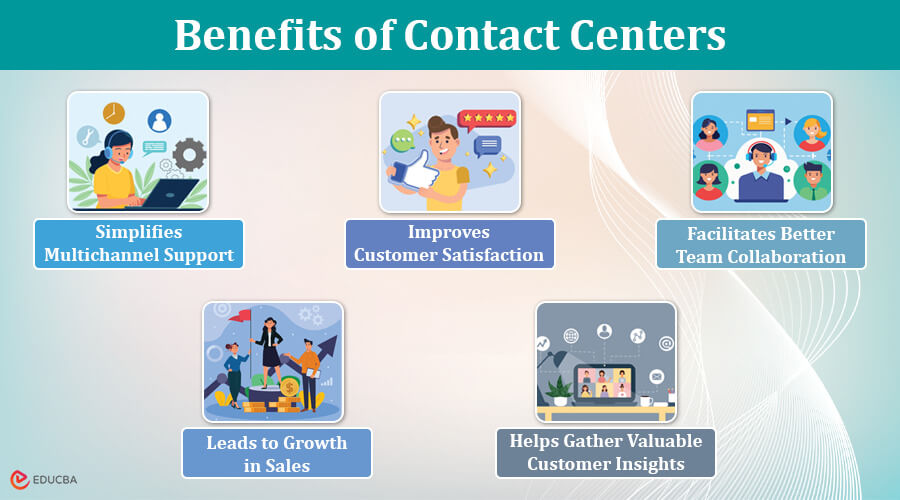
What are Contact Centers?
In business, success depends on many things, like innovative products, competitive prices, online presence, and brand recognition. However, really good customer service is always important to keep customers coming back. Studies show that great service can make customers stay 3.5 times more, which means it’s really important in revenue growth. So, businesses that want to keep customers happy and retain them need to invest in contact centers.
Contact centers, which can include a team or software, help companies maintain efficient communications with their customers. It mostly deals with customer interactions, like calls, chats, emails, texts, social media, and sometimes even faxes.
Customers want to use their preferred ways to talk to businesses and expect quick and personalized responses, and contact centers meet these expectations using special softwares and tools.
Table of Contents
Types
1. Outsourced Contact Centers
Setting up and running a contact center inside a company needs a lot of resources. That’s why many businesses go for outsourced contact centers. These external providers offer expertise, technological infrastructure, and scalability benefits. Outsourced centers are great at delivering support across various channels so businesses can concentrate on their primary strengths.
2. Multichannel Contact Centers
In a multichannel contact center, various communication channels (email, chat, social media, calls) operate independently. It means that interactions on one channel do not connect or reflect on another.
Hence, it can lead to inconsistent service quality. Therefore, businesses need to ensure that all channels work together seamlessly to maintain a unified and positive customer experience.
3. Omnichannel Contact Centers
An omnichannel contact center integrates all channels to provide a seamless and unified experience for customers. It simply means that customer interactions are connected across all channels.
Benefits
1. Simplifies Multichannel Support
Contact centers consolidate customer interactions from various platforms. For example, if a customer starts with a chatbot and then switches to a live agent, the agent can see all previous interactions. This seamless transition ensures efficient service.
2. Improves Customer Satisfaction
By offering multiple communication options, these centers can address different customer needs. For instance, you can handle urgent issues over the phone, while managing routine questions through email or chat. Personalized interactions make customers feel valued and satisfied.
3. Facilitates Better Team Collaboration
They centralize data. It makes it easier for agents to share information and insights. Moreover, the shared knowledge base helps agents resolve issues quickly and consistently. For instance, if one agent discovers a new solution, others can apply it immediately.
4. Leads to Growth in Sales
Modern contact centers use digital and voice channels for revenue opportunities. Agents can upsell or cross-sell, enhancing customer engagement and satisfaction.
5. Helps Gather Valuable Customer Insights
They gather extensive customer data from various interactions. Analyzing this data helps businesses understand trends and customer sentiments. Businesses can use them to develop proactive strategies. For instance, customer interaction feedback can highlight areas for improvement in products or services.
Who Should Utilize Contact Center Services?
Contact centers can enhance any business, but some sectors gain the most value. Here’s a look at who benefits and how:
| Industry | Benefits |
| Retail & E-commerce | Enhance customer engagement and differentiation in a competitive market. |
| Healthcare | Provide empathetic support and manage patient inquiries effectively. |
| Banking & Financial Services | Ensure secure and efficient customer interactions. |
| Automotive | Support high-value purchases with expert assistance. |
Role of AI in Contact Centers
AI is revolutionizing contact centers by improving efficiency and customer satisfaction. Here’s how:
1. AI-Powered Software
AI-powered contact center software can handle customer queries independently on websites, apps, and social media. For instance, chatbots use Conversational AI and NLP to understand and respond to customer messages, resolving issues about 69% of the time without human help. When necessary, they route queries to the right departments and act as virtual assistants integrated with knowledge bases.
2. Sentiment Analysis
Sentiment analysis uses AI to understand customer emotions. By analyzing language and tone, businesses can detect if a customer is happy, frustrated, or angry. It helps in real-time monitoring of interactions to address issues before they escalate. It also provides feedback on agent performance and overall service quality.
3. Real-Time Translation
AI enables real-time translation, allowing customer support in multiple languages. It ensures effective communication with customers worldwide. It simply breaks down language barriers and improves the overall customer experience.
4. AI Assist Tools
AI assist tools, like AI Knowledge Bases and Agent Copilot, provide agents with real-time suggestions and guidance. These tools enhance response quality, speed, and agent productivity by leveraging AI to streamline customer interactions.
5. AI-Generated Transcripts
AI-generated transcripts convert customer interactions into text. It makes it easier to review conversations, train staff, and ensure compliance. This technology provides detailed insights and trends without needing to replay recordings.
Final Thoughts
In the future, contact centers will likely use advanced AI and automation to provide faster and more personalized customer service. Businesses that adapt to these changes and focus on strong contact center solutions will be able to meet customer expectations easily.
Recommended Articles
We hope that you liked this article on contact centers. For more AI and customer-centric articles, refer to the posts below.
